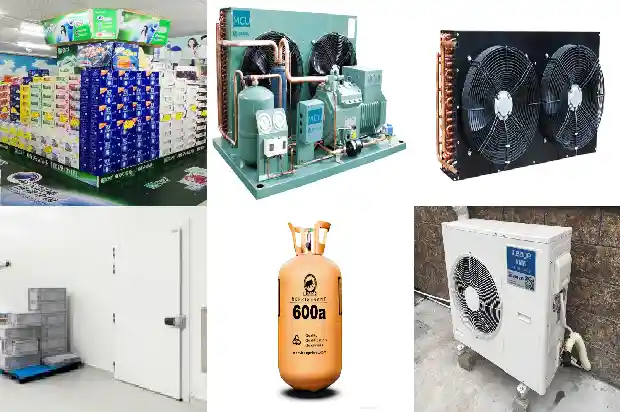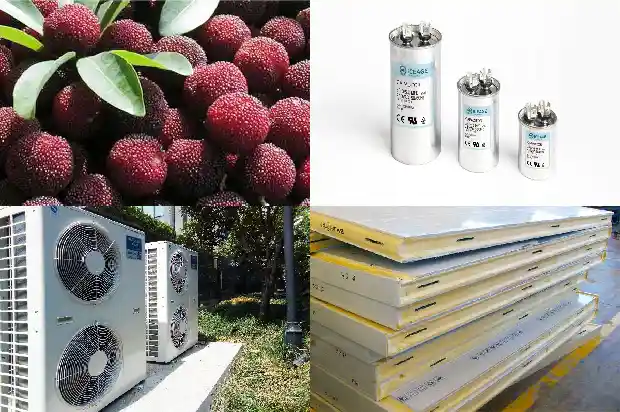Maintenance Methods for Refrigerant Leak in Air - conditioner Outdoor Unit
2024-12-29
I. Refrigerant Leakage in the Pipes Inside the Outdoor Unit
Fault Description: For a certain model of wall - mounted air conditioner, the user reported that it was not cooling.
- Measurement of System Operating Pressure
Turn on the air conditioner in the remote - controlled cooling mode. Both the outdoor fan and the compressor start to operate. However, the air blown from the indoor unit is close to natural wind. When touching the evaporator, only one grid is cool and frosted, and most of it is at room temperature.

Go to the outdoor unit for inspection. Visually, the two - way valve is frosted, and the three - way valve is dry. Connect a pressure gauge to the service port of the three - way valve. The system operating pressure is only 0.15MPa, indicating that the system lacks refrigerant. - Inspection of Leak Points
Turn off the power supply of the air conditioner. Check that the system static pressure is about 0.8MPa, which can be used for leak detection. First, use foam to check the interfaces at the two - way valve and three - way valve of the outdoor unit. After a long - time observation, no bubbles are seen. Then go to the indoor unit, peel off the wrapping tape, and check the interfaces of the thick and thin pipes. After a long - time observation, no bubbles are seen either. This indicates that the interfaces of both the indoor and outdoor units are normal. Use a wrench to tighten the interfaces of the indoor and outdoor units. After turning on the machine again and adding refrigerant to the normal pressure of 0.45MPa, the cooling function returns to normal. - Inspection of the Pipes Inside the Outdoor Unit
About 5 days after the user used the air conditioner, they reported again that it was not cooling. When going for on - site inspection, the system operating pressure dropped to about 0.1MPa again, indicating that there is a refrigerant leakage fault in the refrigeration system. Since the outdoor unit vibrates greatly and has a relatively high failure rate. Remove the top cover and front cover of the outdoor unit. Observe that there are obvious oil marks on the system pipes, indicating that the leak point is in the pipes of the outdoor unit. When using foam for inspection, it is found that the leak point is a crack in the suction pipe of the compressor. The reason is that the suction pipe of the compressor is too close to the connecting pipe of the four - way valve and they collide. When the compressor operates, due to vibration, they rub against each other, causing the pipe wall to become thinner and finally crack, resulting in a refrigerant leakage fault.
Maintenance Measures: Empty the refrigerant in the refrigeration system. Use a welding torch to repair the welds of the suction pipe of the compressor and the connecting pipe of the four - way valve. Then use the top - empty method to remove the air in the system. Check that there are no leak points at the welded parts. After turning on the machine again and adding refrigerant to 0.45MPa, the cooling function returns to normal. Both the two - way valve and three - way valve of the outdoor unit are dewy.
II. There are Porosities in the Welds of the Extended Connecting Pipes
Fault Description: For a certain model of wall - mounted air conditioner, the user reported that the cooling was normal when it was first installed, but the cooling effect became poor after a period of time.
Go for on - site inspection. Turn on the air conditioner for cooling. The outdoor fan and the compressor start to operate, and the air conditioner starts to cool. However, at the air outlet of the indoor unit, the air temperature does not feel cool. When touching the evaporator, part of it is cool and part is at room temperature. It is preliminarily judged that the system lacks refrigerant.
Go to the outdoor unit to check. The two - way valve is frosted, and the three - way valve is dewy. Connect a pressure gauge to the service port of the three - way valve. The system operating pressure is about 0.15MPa, indicating that the system lacks refrigerant. Since it is a newly installed air conditioner and there are extended connecting pipes, the key inspection points are the interfaces of the outdoor unit, the interfaces of the indoor unit, and the welds of the extended connecting pipes.
Use the remote control to turn off the machine. The compressor and the outdoor fan stop running. Check that the system static pressure is about 0.7MPa, which can be used for leak detection. Use detergent foam to check the interfaces of the outdoor unit and the indoor unit, and no leak points are found.
Go for on - site inspection. Turn on the air conditioner for cooling. The outdoor fan and the compressor start to operate, and the air conditioner starts to cool. However, at the air outlet of the indoor unit, the air temperature does not feel cool. When touching the evaporator, part of it is cool and part is at room temperature. It is preliminarily judged that the system lacks refrigerant.
Go to the outdoor unit to check. The two - way valve is frosted, and the three - way valve is dewy. Connect a pressure gauge to the service port of the three - way valve. The system operating pressure is about 0.15MPa, indicating that the system lacks refrigerant. Since it is a newly installed air conditioner and there are extended connecting pipes, the key inspection points are the interfaces of the outdoor unit, the interfaces of the indoor unit, and the welds of the extended connecting pipes.
Use the remote control to turn off the machine. The compressor and the outdoor fan stop running. Check that the system static pressure is about 0.7MPa, which can be used for leak detection. Use detergent foam to check the interfaces of the outdoor unit and the indoor unit, and no leak points are found.
- Extended Connecting Pipes
Unwrap the wrapping tape, find the connection part of the original machine pipes and the extended pipes. Observe that there are obvious oil marks on the thick pipe in the connecting pipes. It is preliminarily judged that the leak point is the weld between the original machine pipe and the extended pipe. - Refrigerant Leakage at the Weld of the Thick Pipe
Apply detergent foam to the weld of the pipe. Check that no bubbles come out from the weld of the thin pipe, but bubbles come out from the weld of the thick pipe, indicating that the refrigerant leakage part is the weld of the thick pipe.
Wipe off the foam on the weld. Carefully check the weld of the thick pipe and find a porosity. This indicates that the installer did not weld the weld well when extending the connecting pipe. The porosity causes the system to leak refrigerant, resulting in the fault of poor cooling effect. - Flaring and Welding the Weld of the Thick Pipe
Turn on the machine again by remote control. After the compressor runs, close the valve core of the two - way valve. When the system pressure becomes negative, quickly close the valve core of the three - way valve to recover the refrigerant in the evaporator and the connecting pipes into the condenser.
Use a cutter to cut off the weld of the thick pipe with porosity, flare it again, and weld it with a welding torch. Use the refrigerant in the condenser to remove the air. Open the valve cores of the two - way valve and three - way valve. Apply detergent foam to the weld of the thick pipe again. Check that no bubbles come out, indicating that the weld of the thick pipe no longer leaks refrigerant.
Maintenance Measures: Re - flare and weld the weld of the thick pipe. After turning on the machine for cooling, add refrigerant R22 to the system until the pressure reaches 0.45MPa, and the cooling function returns to normal.
Summary
① For refrigerant leakage faults in newly installed air conditioners, the interfaces of the outdoor unit, the interfaces of the indoor unit, and the welds of the extended connecting pipes should be checked carefully.
② When installing an air conditioner, if it is necessary to extend the connecting pipes, but if the welding torch is not carried or cannot be used and the welds cannot be welded, the common method is to use quick - connectors to connect the original machine pipes and the extended pipes. However, since the quick - connector has 4 interfaces and needs to flare the bell - mouth on - site during installation, the quick - connector becomes one of the common refrigerant leakage parts.
② When installing an air conditioner, if it is necessary to extend the connecting pipes, but if the welding torch is not carried or cannot be used and the welds cannot be welded, the common method is to use quick - connectors to connect the original machine pipes and the extended pipes. However, since the quick - connector has 4 interfaces and needs to flare the bell - mouth on - site during installation, the quick - connector becomes one of the common refrigerant leakage parts.
Related Articles
- Basic Faults and Preventive Maintenance of Water - cooled Units
- Essential for Maintenance! Parameters and Phenomena of Normal Operation of Refrigeration and Heating Systems
- Welding Equipment Used in Refrigeration System Maintenance
- Maintenance Methods for Small Modular Cold Storage Failures
- Maintenance Techniques for Air - conditioning Refrigeration Systems
- Maintenance Strategies for the Working Cycle and Electrical Automatic Control of Chillers
- Essential Basics for Maintenance, Debugging of Refrigeration and Air - conditioning Systems
- 8 Maintenance Procedures for Industrial Chillers
- Requirements and Maintenance for Building Meat Food Cold Storage
- Maintenance Methods for Faults in Screw Refrigeration Air - conditioner Compressors
- Knowledge, Installation and Maintenance of Cold Storage Systems
- Are you familiar with the detection and maintenance methods of air conditioner components?
- Maintenance and Operation of Freezing and Cold Storage Warehouses
- Water-cooled Screw Chiller: Operation and Maintenance
- Daily Maintenance Training for Users after Installation of Small and Medium-Sized Cold Storages
- Maintenance of Screw Chiller
- Maintenance of Screw Chiller
- On the maintenance and inspection of external insulation layers of pipes in refrigeration devices
